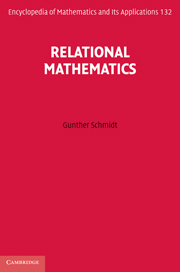Book contents
- Frontmatter
- Contents
- Notes on illustrations
- Preface
- 1 Introduction
- PART I REPRESENTATIONS OF RELATIONS
- PART II OPERATIONS AND CONSTRUCTIONS
- PART III ALGEBRA
- PART IV APPLICATIONS
- 12 Orderings: an advanced view
- 13 Preference and indifference
- 14 Aggregating preferences
- 15 Relational graph theory
- 16 Standard Galois mechanisms
- PART V ADVANCED TOPICS
- Appendix A Notation
- Appendix B Proofs postponed from Part II
- Appendix C Algebraic visualization
- Appendix D Historical annotations
- References
- Symbols
- Index
16 - Standard Galois mechanisms
from PART IV - APPLICATIONS
Published online by Cambridge University Press: 05 May 2013
- Frontmatter
- Contents
- Notes on illustrations
- Preface
- 1 Introduction
- PART I REPRESENTATIONS OF RELATIONS
- PART II OPERATIONS AND CONSTRUCTIONS
- PART III ALGEBRA
- PART IV APPLICATIONS
- 12 Orderings: an advanced view
- 13 Preference and indifference
- 14 Aggregating preferences
- 15 Relational graph theory
- 16 Standard Galois mechanisms
- PART V ADVANCED TOPICS
- Appendix A Notation
- Appendix B Proofs postponed from Part II
- Appendix C Algebraic visualization
- Appendix D Historical annotations
- References
- Symbols
- Index
Summary
The work in this chapter – although stemming from various application fields – is characterized by two antitone mappings leading in opposite directions that cooperate in a certain way. In most cases they are related to one or more relations which are often heterogeneous. An iteration leads to a fixed point of a Galois correspondence. Important classes of applications lead to these investigations. Trying to find out where a program terminates, and thus correctness considerations, also invoke such iterations. Looking for the solution of games is accompanied by these iterations. Applying the Hungarian alternating chain method to find maximum matchings or to solve assignment problems subsumes to these iterations. All this is done in structurally the same way, and deserves to be studied separately.
Galois iteration
When Evariste Galois wrote down his last notes, in preparation for the duel in 1832, in which he expected to die, he probably could not have imagined to what extent these notes would later influence mathematics and applications. What he had observed may basically be presented with the correspondence of permutations of a set and their fixed points. Consider the 5-element sequence {1, 2, 3, 4, 5} for which there exist in total 5! = 120 permutations. The idea is now to observe which set of permutations leaves which set of elements fixed. Demanding more elements to be untouched by a permutation results, of course, in fewer permutations.
- Type
- Chapter
- Information
- Relational Mathematics , pp. 415 - 438Publisher: Cambridge University PressPrint publication year: 2010



